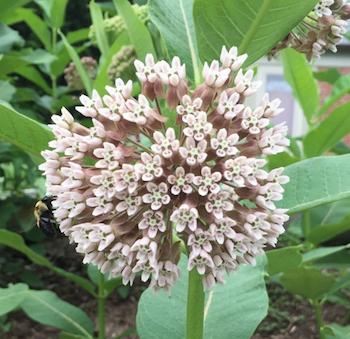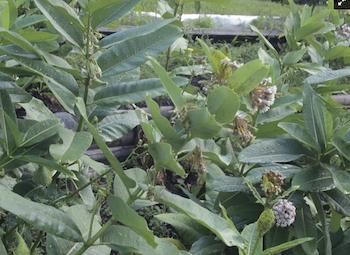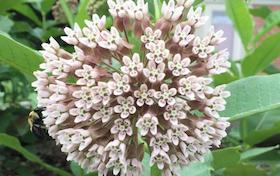My neighbors probably think I’ve lost my mind. Where they have petunias and liriope and neat yards, I have what appear from a distance to be cornstalks on stair steps in my front yard.
The truth is, I lost my mind three years ago — over a butterfly. And those front-yard stalks are filled with “milk” to feed that butterfly’s descendants, should they ever return. That’s right: I am the crazy milkweed lady of Baltimore.

A major factor in the decline of monarch butterflies is the scarcity of its only caterpillar host plant: milkweed. (Rona Kobell)
It all started with a tiny monarch egg. Three years ago, my older daughter, then 8, wanted to tag a butterfly. I got us into a program to do so at Cromwell Valley Park near Towson, Md. We came home not with a tagged butterfly, but with four Ziploc bags containing eggs. I did not think any would become caterpillars. But one did.
We called her Saige Stripey, after an American Girl doll and because of the distinct, dark lines on her orange wings. She was with us just a few weeks, but during that time, she became a part of my life. I fed her, changed her bedding and checked on her probably more than I did my own young children.
Basically, I turned my life upside down for this butterfly. There were late-night trips to the garden store, a sanctioned but still furtive visit to Cromwell Valley to pull up some of their milkweed, and constant watching. (Can you be a helicopter parent to a butterfly?)
My daughter kept the caterpillar in her room, watched it transform into its J shape and then close up into its chrysalis. I had plans to go to a conference in Chattanooga, and it still had not busted out of its pupa. I left my husband with instructions to call the nature center for a tag if it did. The day before I left Chattanooga, he called me there to tell me we had a butterfly. My daughter wanted to wait until I got home so we could release it together. I urged them to do it without me (though I briefly considered changing my flight — I told you, I lost my mind a bit), but they wanted to wait.
When I got home, my daughter carefully took Saige out of her cage and released her. With a garden full of plants and even some milkweed, we thought maybe she’d stick around. But she flew away so fast I could barely snap a photo.
I talked with Tom Culbertson, a landscaper for Sunshine Tree and Landscape who grew up down the street and helps me manage my yard. If I planted milkweed, I asked, would we see butterflies? He cautioned me that milkweed is tough to grow. And you can’t just get it in the garden store. But he had a friend who had access to some, and it was native, so he said he’d see what he could do. Tom came through, and we decided to plant it in the front yard, on terraced steps. It was a bit unusual, but I hoped it would work.

A bed of milkweed may not look like much at first, but when it blooms watch the insect action. (Rona Kobell)
The first year was rough. The plants toppled, and they didn’t flower. Weeds abounded. I wondered if the whole endeavor had been a mistake.
But this year, the milkweed has looked pretty good. We’ve had pods, flowers, and caterpillars, not to mention pollinators. My daughter saw one monarch. I missed it, but I’ve seen many cabbage whites, and a few days ago I saw a tiger swallowtail.
Among the human visitors who have commented on the milkweed and correctly identified it are: my plumber, my HVAC guy, the UPS guy, and my friend Rachael. It turns out I am not the only person who loves butterflies.
My older daughter, now 11, has moved on to other, more obscure insects. And Harry Potter. But I guess Saige stayed with us all, a little bit. We talk about her. And now that my younger one is 5, I wonder if it’s time to try raising a butterfly again.
So there have been a few butterflies, but not lots, and only one monarch. We keep waiting, and wondering if more monarchs will come back, if we will see Saige’s progeny flutter about. If they do return, it will be my way of saying sorry to my neighbors; I planted a garden with a lot of weeds, but eventually, it brought rewards.
By Rona Kobell, Bay Journal News Service
Bay Journal writer Rona Kobell is a former Baltimore Sun reporter.



Write a Letter to the Editor on this Article
We encourage readers to offer their point of view on this article by submitting the following form. Editing is sometimes necessary and is done at the discretion of the editorial staff.